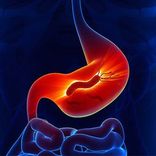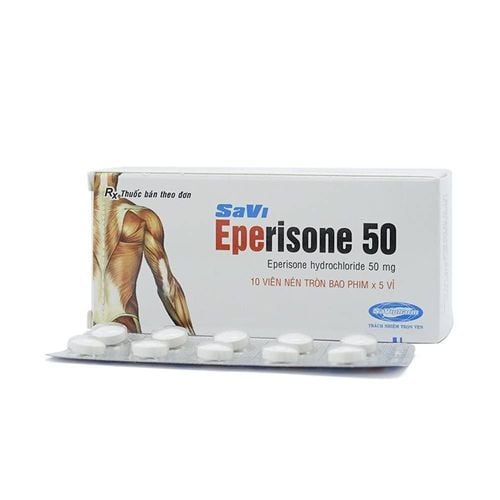Written by Pharmacist Quang Anh Nguyet – Head Pharmacist of Vinmec Central Park International Hospital Pharmacy Department.
Mydocalm is a centrally acting muscle relaxant prescribed by doctors to treat muscle stiffness and spasms. To ensure effective treatment, patients must follow the instructions provided by their healthcare provider or pharmacist.
1. Composition, Uses, and Indications of Mydocalm
Mydocalm contains Tolperisone and comes in two dosages: 50 mg and 150 mg. So what is Mydocalm? Mydocalm is a centrally acting muscle relaxant with an unclear mechanism of action.
Tolperisone stabilizes membranes and has local anesthetic properties. It inhibits signal transmission in sensory nerves and motor neurons, suppressing mono- and polysynaptic reflexes. Additionally, it inhibits calcium ion influx into synapses, potentially reducing neurotransmitter release. In the brainstem, Tolperisone suppresses the spinal reflex. Studies on animal models have shown that it reduces increased muscle tone and stiffness following cerebral injury.
Tolperisone also improves peripheral circulation independently of its central nervous system effects. This may result from its mild antispasmodic and anti-adrenergic properties.
2. Indications and Contraindications
Mydocalm is indicated for treatment of muscle stiffness and spasms. Otherwise, Mydocalm is contraindicated in:
- Patients allergic to Tolperisone or chemically similar substances (e.g., Eperisone) and excipients.
- Individuals with myasthenia gravis.
- Children under 3 months old (the manufacturer advises against use in individuals under 18).
3. Dosage and Administration
Mydocalm should be taken during or after meals with a glass of water. The particular dosage for each group of individuals is:
3.1. Adults
The recommended dose is 50–150 mg three times daily. Following that, the medication should be taken during or after meals with a glass of water.
3.2. Children
The manufactured company does not recommend using the medication for those under 18 due to limited safety and efficacy data. The use of this medication for this group depends on the doctor’s decision after weighing the benefits and risks.
- Children 3 months–6 years: 5 mg/kg/day, divided into three doses.
- Children 6–14 years: 2–4 mg/kg/day, divided into three doses.

3.3. Special Populations
Adjust dosage for patients with moderate liver or kidney impairment and closely monitor their condition. Mydocalm is not recommended for patients with severe liver or kidney impairment.
4. Side Effects of Mydocalm
The adverse effects of using tolperisone primarily involve skin and subcutaneous tissue reactions, systemic disorders, nervous system disorders, and gastrointestinal disturbances. Specifically:
- Allergic reactions: itching, rash, or erythema (usually mild and self-resolving). Rare but severe reactions, such as angioedema, anaphylactic shock, or difficulty breathing, may occur.
- Neurological symptoms: muscle weakness, fatigue, headaches, dizziness.
- Gastrointestinal symptoms: nausea, abdominal discomfort (often alleviated by dose adjustment).
- Other rare effects: increased sweating, confusion.
Patients should inform their doctor of any side effects experienced while using Mydocalm.
5. Use During Pregnancy and Breastfeeding
Animal studies have shown no teratogenic effects of Tolperisone. However, due to limited clinical data, Mydocalm is not recommended during pregnancy, especially in the first trimester, unless the benefits outweigh the risks. The presence of Tolperisone in breast milk is unknown; therefore, it should not be used while breastfeeding.
6. Other precautions when using Mydocalm
Cases of Mydocalm overdose are rare due to its wide therapeutic range. Overdose symptoms, as observed in preclinical studies, include ataxia (loss of muscle coordination), tonic-clonic seizures, respiratory distress, and respiratory paralysis. There is no specific antidote for Mydocalm overdose; treatment is symptomatic and supportive.

7. Individuals requiring cautions when using Mydocalm
Special care is advised for:
- Individuals with a history of drug allergies.
- Patients with liver or kidney dysfunction.
- Individuals who drive or operate machinery. Mydocalm generally does not impair these abilities, but patients experiencing dizziness, blurred vision, or muscle weakness when using tolperisone should consult their doctor.
Mydocalm is a centrally acting muscle relaxant prescribed by doctors to treat muscle stiffness and spasms. Always follow your doctor or pharmacist’s instructions when using Mydocalm. Contact a healthcare provider immediately if any unusual symptoms occur.
To arrange an appointment, please call HOTLINE or make your reservation directly HERE. You may also download the MyVinmec app to schedule appointments faster and manage your reservations more conveniently.
References:
- Manufacturer's manual.
- Vinmec's handbook on drug use.









